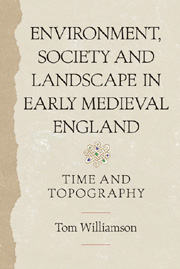Book contents
- Frontmatter
- Contents
- List of Illustrations
- Acknowledgements
- Introduction
- 1 Settlement and Society
- 2 Nature's Frame
- 3 Culture, Ethnicity and Topography
- 4 Small Shires, Deep Roots
- 5 The Gradient of Freedom
- 6 Two Countrysides?
- 7 Village, Farm and Field
- 8 Landscape and Settlement
- 9 Woodland and Pasture
- Conclusion: Time and Topography
- Bibliography
- Index
- ANGLO-SAXON STUDIES
6 - Two Countrysides?
Published online by Cambridge University Press: 05 April 2013
- Frontmatter
- Contents
- List of Illustrations
- Acknowledgements
- Introduction
- 1 Settlement and Society
- 2 Nature's Frame
- 3 Culture, Ethnicity and Topography
- 4 Small Shires, Deep Roots
- 5 The Gradient of Freedom
- 6 Two Countrysides?
- 7 Village, Farm and Field
- 8 Landscape and Settlement
- 9 Woodland and Pasture
- Conclusion: Time and Topography
- Bibliography
- Index
- ANGLO-SAXON STUDIES
Summary
Introduction
Interesting though spatial differences in Saxon social and tenurial organisation may be to some researchers, most landscape historians and archaeologists have concentrated their attention on other aspects of regional variation in early-medieval England, and in particular on the ways in which patterns of settlement, and the character of field systems, developed in radically different ways in different parts of the country. By the thirteenth century the central areas of England were characterised by what many describe as ‘champion’ countryside. They possessed a settlement pattern of nucleated villages whose inhabitants practised highly communal forms of agriculture. The holdings of individual farmers – and usually the demesnes, or home farms, of manorial lords – lay intermingled, as a multiplicity of small unhedged strips which were usually scattered evenly through two or three extensive open fields. Such landscapes predominated in a broad belt of countryside extending across the centre of England all the way from Northumberland to the south coast. To the south-east of this ‘village zone’, and to the west, ‘woodland’ landscapes of various kinds could be found (Figure 19). In these districts, settlement was less nucleated in character and where villages existed they did so alongside other forms of habitation – hamlets, loose agglomerations of dwellings around small greens or extensive commons, and isolated farms standing in the midst of their own fields.
- Type
- Chapter
- Information
- Environment, Society and Landscape in Early Medieval EnglandTime and Topography, pp. 125 - 146Publisher: Boydell & BrewerPrint publication year: 2012



